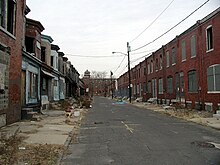美国贫困问题


相比于其他发达国家,美国的贫困问题相对严重,贫困率也较高。
美国政府对相对贫困的定义是“缺乏主流社会拥有的生活物资,无法享受主流社会应有的服务”[1]。2015年的调查数据表明,美国13.5%的人口是贫困的[2]。但也有观点认为大约三分之一的美国人(大约一亿人)生活在贫困线下,或生活水平仅略高于贫困线[3]。同时有观点指出,大约一半的美国人相对贫困或属于低收入群体[4]。赤贫人口方面,2011年,美国有150万个日均开支少于两美元的赤贫家庭,较1996年翻了一番,其中包括280万名孩童[5]。2016年,国际货币基金组织(IMF)警告称,高贫困率是美国亟需解决的问题[6]。
20世纪30年代,美国的相对贫困人口开始多于富裕人口。2009年,美国的贫困率已回到20世纪60年代美国总统林登·约翰逊发起的“向贫困宣战”运动开始前的水平[7]。美国的儿童贫困率近年日趋严重。美国的儿童贫困率在2011年达到高峰,大约有167万名孩童缺乏足够的食物,相比2007年的数据上升了35%。根据一份联合国儿童基金会2012年的报告,美国的儿童贫困率为23.1%,在发达国家中第二高,仅低于罗马尼亚[8][9]。
美国城市郊区的贫困率低于市中心和农村地区[10][11]。大部分的美国人在25至75岁之间会有一段时间生活在贫困线以下[12]。美国相对贫困率最低的州是新罕布什尔州、佛蒙特州、明尼苏达州和内布拉斯加州[13]。
对贫困的定义
| 家庭人口 | 48州和华盛顿特区 | 阿拉斯加 | 夏威夷 |
|---|---|---|---|
| 1 | $12,140 | $15,180 | $13,960 |
| 2 | $16,460 | $20,580 | $18,930 |
| 3 | $20,780 | $25,980 | $23,900 |
| 4 | $25,100 | $31,380 | $28,870 |
| 5 | $29,420 | $36,780 | $33,840 |
| 6 | $33,740 | $42,180 | $38,810 |
| 7 | $38,060 | $47,580 | $43,780 |
| 8 | $42,380 | $52,980 | $48,750 |
| +[註 1] | $4,320 | $5,400 | $4,970 |
美国联邦政府有两个主要的贫困标准,一个是由美国人口调查局制定的“贫困线”(poverty thresholds),主要用于估算贫困人口,并对其种族、性别、年龄进行统计[15];一个是由美国卫生及公共服务部制定的“贫困指南”(poverty guidelines),主要用于测评相关人士或家庭是否符合领取救济金的标准[16]。美国经济学家莫莉·奥珊斯基对美国贫困标准的制定做出了巨大贡献。她认为应该基于人必须的饮食开销以及家庭的人口来制定贫困标准[17][18]。目前,如果一个家庭的收入少于基本食品开销7.8倍(过去的标准是3倍[註 2]),那么就可以认为这个家庭生活在贫困线以下[19]。
具体情况
在美国,黑人的贫困率高于白人。此外,西班牙裔美国人贫困率相对较高。2014年的调查显示,10.1%的贫困人口是非西裔白人、12%的贫困人口是亚裔,西裔、黑人、原住民贫困人口占总贫困人口的大头,分别占总贫困人口的23.6%、26.2% 、28.3%[20]。贫困率也与家庭组成有关。根据2007年的统计数据,单亲家庭的贫困率最高,为26.6%,其次是单身者,为19.1%,而完整家庭的贫困率相对较低,仅有5.8%[21]。调查数据表明,超过75%的贫困家庭的主要收入来自家中的女性[22]。美国贫困人口的监禁率远高于其他发达国家[23]。
美国的儿童贫困问题和长者贫困问题较为突出。根据2010年经济合作与发展组织(OECD)的调查报告,美国的儿童贫困率是20%,而长者贫困率是23%[24]。相当比例的儿童面临饥饿的威胁[25]。2011年,美国的儿童贫困率达到历史最高位,约有167万名孩童无法获得充足的食物,相比2007年的数据上升了35%。联合国儿童基金会(UNICEF)发表于2012年的报告指出,美国的儿童贫困率为23.1%,在发达国家中仅比罗马尼亚低[8][9]。研究表明贫困人口也更难获得更好的教育,来自贫困家庭的孩童教育发展明显受到限制。另一方面,许多美国贫困人口教育水平较低。低学历被认为是造成贫困的重要原因之一[26][27]。
不过,也有观点认为,美国的贫困问题被夸大了。保守派的美国传统基金会在2011年称,美国的贫困人口大都能获得充足的饮食、服装,以及医疗服务,亦有可供居住的住所[28][29][30]。2005年的统计表明,78.3%的贫困家庭有空调[31][32]。史迪芬·平克在一篇发表于《华尔街日报》的文章中提出了他对贫困的新定义。按他的标准,美国2018年的贫困率应为3%,比1988年的11%要低[33]。
造成贫困的原因

在美国,收入分配不均是造成贫困人口的重要原因之一[34]。此外,学历偏低的人群中贫困率更高,高教育水平人群的收入水平相对较高,有相对低的贫困率[27][35]。失业者更容易处于贫困之中。根据2007年的统计数据,21.5%的失业者是贫困人口,而仅有2.5%的全职工作者是贫困人口[35]。有研究表明美国的社会保障制度确实促进了贫困率的下降,如果没有现行的社会保障制度,贫困率将会更高[36][37]。但尽管如此,美国的社会保障制度却是发达国家中最脆弱的。美国低程度的社会保障开销是贫困率相对较高的原因之一[38][39]。
参见
注释
参考资料
- ^ Schwartz, J. E. Freedom Reclaimed: Rediscovering the American Vision. Baltimore: Johns Hopkins University Press. 2005. ISBN 0-8018-7981-7.
- ^ "Basic Statistics - Talk Poverty". Talk Poverty. Retrieved October 27, 2015.
- ^ Haymes, Stephen N.; et al (编). Routledge Handbook of Poverty in the United States. London and New York: Routledge. 2015: 7. ISBN 978 0 41 567344 0.
- ^ Census data: Half of U.S. poor or low income. CBS News, December 15, 2011. Retrieved February 10, 2014.
- ^ "Extreme Poverty in the United States, 1996 to 2011" National Poverty Center, February 2012
- ^ IMF warns the US over high poverty. BBC, June 22, 2016.
- ^ Woolf, Steven; Aaron, Laudon. U.S. Health in International Perspective. National Research Council and Institute of Medicine: 171–172. [2014-02-11].
- ^ 8.0 8.1 Walker, Duncan. The children going hungry in America. BBC News. 2013-03-06 [2013-03-13].
- ^ 9.0 9.1 UNICEF. Measuring child poverty - New league tables of child poverty in the world's rich countries (PDF). UNICEF. [2018-10-11].
- ^ Savage, Sarah. Child Poverty High in Rural America (PDF). [2008-08-26]. (原始内容 (PDF)存档于2008-09-09).
- ^ Child Poverty High in Rural America Newswise, Retrieved on August 26, 2008.
- ^ Hacker, J. S. The Great Risk Shift: The New Insecurity and the Decline of the American Dream. New York: Oxford University Press. 2006. ISBN 0-19-533534-1.
- ^ Renwick, Trudi; Fox, Liana. The Supplemental Poverty Measure: 2015. United States Census Bureau. 2016-09-13.
Number and Percentage of People in Poverty by State Using 3-Year Average Over 2013, 2014, and 2015
- ^ 2018 Poverty Guidelines. Aspe.hhs.gov. 2018-02-07 [2018-02-07].
- ^ How the Census Bureau Measures Poverty. census.gov. United States Census Bureau. [2015-09-16]. (原始内容存档于2010-07-11).
- ^ 2015 POVERTY GUIDELINES. hhs.gov. United States Department of Health and Human Services. [2015-09-03].
- ^ Mollie Orshansky. Children of the Poor. Social Security Bulletin, Vol. 26, No. 7, July 1963, pp. 3-13.
- ^ Mollie Orshansky. Counting the Poor: Another Look at the Poverty Profile. Social Security Bulletin, Vol. 28, No. 1, January 1965, pp. 3-29
- ^ Blank, Rebecca M. Why the United States Needs an Improved Measure of Poverty. Brookings. 2008-07-17 [2018-08-31] (美国英语).
- ^ "Income and Poverty in the United States: 2014". U.S. Census Bureau
- ^ U.S. Census Bureau. Current Population Survey. Persons in Families by Family Structure, Age, and Sex, Iterated by Income-to-Poverty Ratio and Race: 2007: Below 100% of Poverty – All Races 互联网档案馆的存檔,存档日期2008-09-30..
- ^ Dáil, Paula vW. Women and Poverty in 21st Century America. NC, USA: McFarland. 2012: 27. ISBN 978-0-7864-4903-3.
- ^ Perspectives on Inequality and Opportunity from the Survey of Consumer Finances. Board of Governors of Federal Reserve System. [2016-12-26].
- ^ OECD (2008), Growing Unequal? : Income Distribution and Poverty in OECD Countries : COUNTRY NOTE: UNITED STATES (PDF). Oecd.org. [2017-10-14].
- ^ 3.5M Kids Under 5 On Verge Of Going Hungry
Study: 11 Percent Of U.S. Households Lack Food For Healthy Lifestyle ("SHTML). Health (CBS NEWS). 2009-05-07 [2009-05-08]. - ^ Engle, Patrice L.; Black, Maureen M. The Effect of Poverty on Child Development and Educational Outcomes. Annals of the New York Academy of Sciences. 2008, 1136 (1): 243–256. ISSN 0077-8923. doi:10.1196/annals.1425.023.
- ^ 27.0 27.1 Western, B. & Pettit, B., (2010). Incarceration and social inequality. Daedalus, 139(3), 8-19
- ^ Jonathan Rothwell (November 8, 2011). Why Heritage Is Wrong About Poverty in America. The New Republic Retrieved November 18, 2014.
- ^ Melissa Boteach and Donna Cooper (August 5, 2011). What You Need When You're Poor; Heritage Foundation Hasn't a Clue. Center For American Progress. Retrieved November 18, 2014
- ^ Courtland Milloy (September 13, 2011). Study dismisses poverty, but try telling that to the poor. The Washington Post. Retrieved November 18, 2014.
- ^ Rector, Robert; Rachel, Sheffield. Air Conditioning, Cable TV, and an Xbox: What is Poverty in the United States Today?. The Heritage Foundation. 2011-07-18 [2011-07-27].
- ^ Timbro. E.U. vs U.S.A (PDF). [2007-11-10]. (原始内容 (PDF)存档于2016-11-15).
- ^ Steven Pinker. The Enlightenment is Working. Wall Street Journal. 2018-02-09 [2018-02-11].
- ^ Adams, R. H., (2004). Economic growth, inequality, and poverty: Estimating the growth elasticity of poverty, World Development 32(12), p. 1989-2014.
- ^ 35.0 35.1 U. S. Census: Income, Expenditures, Poverty and Wealth (PDF). [2010-03-20].
- ^ Drum, Kevin (December 9, 2013). New Study Says Poverty Rate Hasn't Budged For 40 Years. Mother Jones. Retrieved February 15, 2014.
- ^ Zachary A. Goldfarb (December 9, 2013). Study: U.S. poverty rate decreased over past half-century thanks to safety-net programs. The Washington Post. Retrieved January 20, 2015.
- ^ Kenworthy, L. Do Social-Welfare Policies Reduce Poverty? A Cross-National Assessment. Social Forces. 1999, 77 (3): 1119–1139. doi:10.1093/sf/77.3.1119.
- ^ Bradley, D., E. Huber, S. Moller, F. Nielsen, and J. D. Stephens. Determinants of Relative Poverty in Advanced Capitalist Democracies. American Sociological Review. 2003, 68 (1): 22–51. doi:10.2307/3088901.
